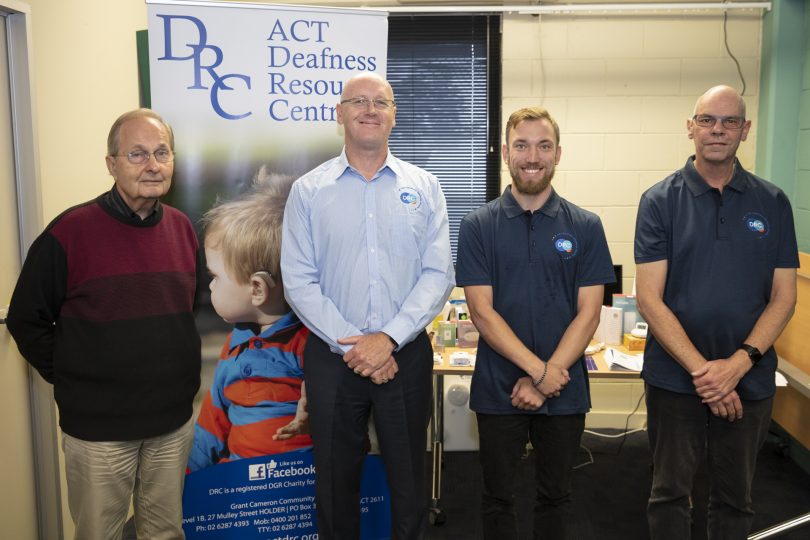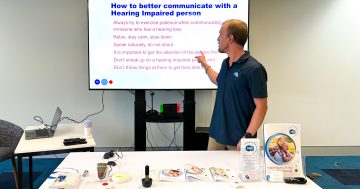
Lip reading is impossible with a face mask in place. Photo: Canberra Health Services.
Communication can be a challenge for the deaf and hearing-impaired, and the mandatory wearing of face masks during COVID-19 has only made it more so.
People with hearing loss rely on facial expressions and clear speech when interacting with others, and a patch of cloth across the mouth of a speaker robs them of this ability.
Depending on the type of face mask, studies have shown they can reduce the clarity of speech and lower the volume between five and 15 decibels. Speech is not only quieter when wearing a mask, but also more muffled.
The mask straps also interfere with devices such as hearing aids, which sit behind the user’s ears.
Add in social distancing requirements, and ACT Deafness Resource Centre CEO Glenn Vermeulen says the deaf and hearing-impaired community face another layer of difficulty when coping with the COVID-19 pandemic.
“It’s an issue that first came up months ago when governments were suggesting the use of face masks,” he says.
“At the time, advocacy groups such as the Deafness Forum of Australia stood up and said, ‘Look, you can’t expect people who rely on lip reading to communicate with people wearing a mask’.'”
It was an exception that had to be made, and in the mask mandates that have followed in the Australian states and territories since then, governments have made sure to include communication with the deaf and hearing-impaired as a valid excuse to remove a face mask.

Glenn Vermeulen (second from left) and the ACT Deafness Resource Centre team offer help to people with hearing needs. Photo: Thomas Lucraft.
Although the mask mandate in the ACT ended on 9 July, 2021, across the border in regional NSW, face masks must still be worn in all indoor, non-residential venues. This includes shopping centres, airports and public transport, as well as some outdoor venues.
The rules state: “You can take off your face mask when you need to communicate with someone who is deaf or hard of hearing, and seeing the mouth is essential. It is important to keep 1.5 metres apart, where practicable”.
This exception was also in place in the ACT, but Glenn says the trouble was that “hardly anyone knew about it and many people were therefore reluctant to remove their masks”.
Since then, other solutions have emerged such as a plastic shield that fits over the head and covers the face, or a conventional face mask but with a clear sheet of plastic over the mouth.
“You have to take the good with the bad,” says Glenn.
“Yes, it means others can still feel secure wearing the mask, and the hearing-impaired person can lip-read, but they still can’t hear very well. The plastic distorts the voice.”
There is also the option of designing a custom mask that includes a slogan to alert others that you are hearing-impaired, but some people might consider that a breach of privacy or dislike the label.
Deaf Services has released a number of graphics that can be downloaded to a phone and quickly shown to someone to alert them to a person’s hearing loss.
The ACT Deafness Resource Centre has a list of tips for communicating with the deaf and hearing-impaired, which include:
- Get the person’s attention before speaking.
- Make sure there is enough light on the face of the person speaking to enable the other person to lip-read easier.
- Use sentences rather than single words, but keep them short and to the point.
- If the person does not understand what you have said, try rephrasing the sentence, or writing down the information.
- Where possible, speak at eye level.
- Do not eat, chew gum or hold a pen, etc, in your mouth when speaking.
- Do not shout or emphasise words.
- Never say, ‘Oh forget it, it doesn’t matter – it’s not important’.


















